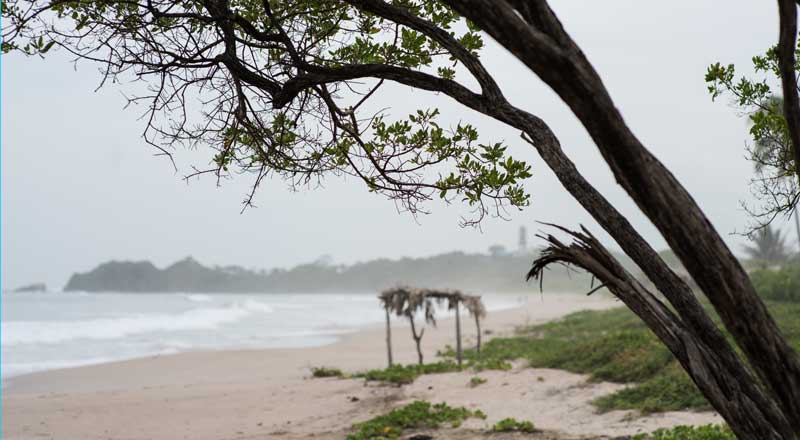Playas Guiones and Pelada are the heart of our community, where we enjoy walking, running, surfing, volleyball, or simply contemplating the sunset on our pristine beaches any day of the week.
But the new Ostional Law contains measures that could bring irreparable damage. Below, read what we’re proposing to the Minister of Enviroment to guarantee that the place we love remains protected and green.
The Spanish version of this proposal appeared in La Nacion on Saturday, September 24. Click here to view PDF.
 Playa Guiones
Playa Guiones
Playa Guiones and Pelada in Danger
Guiones and Pelada, two distinct beaches located in the Nicoya canton, are in danger of irreversible change. Their natural beauty and their ecological and economic importance are threatened for two reasons: 1) Article 26 of Law 9348 of the Ostional Wildlife Refuge (RVSO), approved last March, and 2) the zoning proposed by SINAC (National System of Conservation Areas) in the RVSO Management Plan, presented in August 2014.
While Law 9348 proposes a management system in accordance with new global trends of harmonious human-environmental interaction, Article 26 and SINAC’s proposed zoning permit excessive changes in land use within the Refuge, creating a precedent that puts other conservation areas at risk.
Through a system of concessions, Law 9348 protects hundreds of Ostional families from possible removal and relocation because of the area’s government- protected status. Law 9348 takes into consideration that these people were living here long before the creation of the Refuge, and because they take an active role in conserving Olive Ridley turtles (Lepidochelys olivacea).
The Ostional community has a right to harvest the eggs laid by the first turtles to nest on the beach during the monthly phenomenon called the arribada. Many of these eggs would otherwise be destroyed by subsequent nesting of hundreds to thousands of turtles. This activity generates income for the entire community, and at the same time makes Ostional residents responsible for protecting the turtles’ nesting habitat — a true model of sustainable natural resource management. According to data from the University of Costa Rica, the number of turtles that nest on Ostional beach is increasing, demostrating a mutually beneficial relationship.
However, Article 26 of this law, which refers to land use on private property, along with the zoning proposed by SINAC in the RVSO Management Plan, opens a door to construction of new buildings on more than 100 parcels within the 150 meters of currently protected green beachfront area from Río Montaña to Punta India — that is, 40% of the protected land area.
This excessive alteration of the Refuge would benefit a few in Guiones and Pelada, while endangering the environment, the local economy, and the major part of the population. It would be not one but many steps backward in making a model sustainable community that residents have been working for years to create.
The RVSO Management Plan omits essential information that justifies protection of this sector. It does not acknowledge BarriGuiones, a project which since 2011 has carried out 5 reforestation campaigns on the edge of the beach forest, planting 15,000 trees, including 40 threatened or endangered species.
It also overlooks the TortuGuiones project, which with the help of more than 100 volunteers and demarcation every 50 meters along the length of the two beaches, has to date reported more than 100 sightings of turtles on Guiones and Pelada beaches.
Both projects, led by environmental groups and supported by hundreds of local volunteers, have been a community response to protect and recover the area’s natural resources, demonstrating the community’s willingness to cooperate with SINAC in light of its limited resources and personnel.
In addition to its ecological merits, this natural barrier has highly important economic value for the Nosara community. The natural beauty of its beaches, unspoiled by private edifices, attracts almost 50,000 tourists with considerable purchasing power, year after year, to this rural, isolated, hard-to-reach town.
Our proposal for protecting the Guiones and Pelada sector is to include in the “Focal Element of Management” (EFM) in the Management Plan, the protection of the nesting habitat of the marine turtles —not only the Ostional beach as established in the current plan— and the protection of the coastal forest. Both are fundamental objectives of the RVSO.
By extending this protection, we expect that the Management Plan and SINAC’s zoning will be modified to prohibit new construction or no other human intervention in the natural barrier of 200 meters on Guiones and Pelada beaches.
If we do not fight for the areas already protected by law, what future can we expect for our country’s natural resources?
Jessica Sheffield Zamora
Master in Natural Resource Management, Blue Flag Commitee of Nosara
Ethel Araya Chaves
Economist, Vice President, Asociación Cívica de Nosara
Francisco Jiménez González
Geographer, Asociación Cívica Nosara
